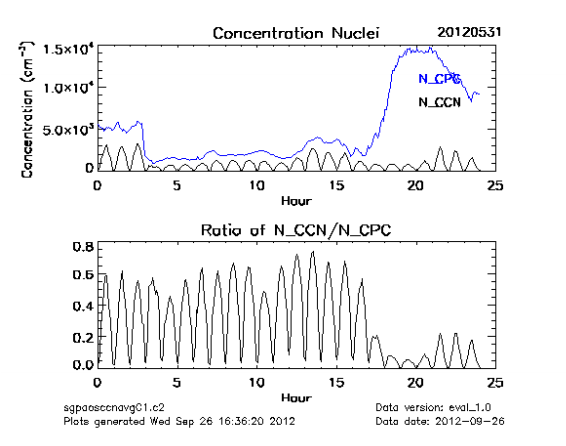AOSCCNAVG
Aerosol Observing System (AOS): cloud condensation nuclei data, averaged
Baseline VAP

This value-added product was developed to consolidate the relevant cloud condensation nuclei (CCN) parameters into a single file and averaged the data over the 5-minute integration time of each percent supersaturation (%ss) value. The surface sites measure the CCN concentration at several supersaturations using a single-column CCN counter (Roberts and Nenes, 2005). The percent supersaturation of the instrument is stepped through seven intervals every 30 minutes, with 5 minutes at each setting in a pyramid profile. The first minute after a change in %ss, the CCN temperatures are unstable, and the %ss value usually overshoots the set point value. For this reason, the first minute of every %ss setting is disregarded and only the last 4 minutes are averaged together.
The %ss in the CCN datastream is calculated using a heat transfer and fluid dynamics model flow model (Lance et al., 2006). The model uses the calibrated temperature, pressure, and flows in the instrument to calculate the %ss. Small variations in the %ss will arise from changes in the column thermal properties in the instrument. Rose et al. (2008) discuss the model and salt calibration calculations of the instrument %ss and uncertainty associated with thermal properties. The calculated %ss value was chosen to be more reliable than the static calibration obtained via salt aerosol because the %ss value changes dynamically with the instrument flow, pressure, and room temperature, and because salt calibrations are inconvenient at remote locations and happen infrequently.
For more details, see Aerosol Observing System Cloud Condensation Nuclei Average (AOSCCNAVG) Value-Added Product.
Primary Derived Measurements
Contact
View all contacts-
John ShillingTranslator Pacific Northwest National Laboratory
Related Data Announcements
References
View all references- Bergner et al. "Characteristics and effects of aerosols during blowing snow events in the central Arctic". 2025. 10.1525/elementa.2024.00047.
Locations
Keep up with the Atmospheric Observer
Updates on ARM news, events, and opportunities delivered to your inbox
ARM User Profile
ARM welcomes users from all institutions and nations. A free ARM user account is needed to access ARM data.


















